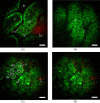In vivo imaging of unstained tissues using long gradient index lens multiphoton endoscopic systems
- PMID: 22567597
- PMCID: PMC3342183
- DOI: 10.1364/BOE.3.001077
In vivo imaging of unstained tissues using long gradient index lens multiphoton endoscopic systems
Abstract
We characterize long (up to 285 mm) gradient index (GRIN) lens endoscope systems for multiphoton imaging. We fabricate a portable, rigid endoscope system suitable for imaging unstained tissues, potentially deep within the body, using a GRIN lens system of 1 mm diameter and 8 cm length. The portable device is capable of imaging a ~200 µm diameter field of view at 4 frames/s. The lateral and axial resolution in water is 0.85 µm and 7.4 µm respectively. In vivo images of unstained tissues in live, anesthetized rats using the portable device are presented. These results show great promise for GRIN endoscopy to be used clinically.
Keywords: (110.2760) Gradient-index lenses; (170.2150) Endoscopic imaging; (180.4315) Nonlinear microscopy.
Figures






Similar articles
-
Three-photon excited fluorescence imaging of unstained tissue using a GRIN lens endoscope.Biomed Opt Express. 2013 Apr 1;4(5):652-8. doi: 10.1364/BOE.4.000652. Print 2013 May 1. Biomed Opt Express. 2013. PMID: 23667782 Free PMC article.
-
Singlet gradient index lens for deep in vivo multiphoton microscopy.J Biomed Opt. 2012 Feb;17(2):021106. doi: 10.1117/1.JBO.17.2.021106. J Biomed Opt. 2012. PMID: 22463024
-
Multiphoton gradient index endoscopy for evaluation of diseased human prostatic tissue ex vivo.J Biomed Opt. 2014 Nov;19(11):116011. doi: 10.1117/1.JBO.19.11.116011. J Biomed Opt. 2014. PMID: 25415446 Free PMC article.
-
Aberration correction in long GRIN lens-based microendoscopes for extended field-of-view two-photon imaging in deep brain regions.Elife. 2025 May 2;13:RP101420. doi: 10.7554/eLife.101420. Elife. 2025. PMID: 40314426 Free PMC article.
-
In vivo imaging of unstained tissues using a compact and flexible multiphoton microendoscope.J Biomed Opt. 2012 Apr;17(4):040505. doi: 10.1117/1.JBO.17.4.040505. J Biomed Opt. 2012. PMID: 22559671 Free PMC article.
Cited by
-
Ultrahigh-resolution optical coherence elastography through a micro-endoscope: towards in vivo imaging of cellular-scale mechanics.Biomed Opt Express. 2017 Oct 20;8(11):5127-5138. doi: 10.1364/BOE.8.005127. eCollection 2017 Nov 1. Biomed Opt Express. 2017. PMID: 29188108 Free PMC article.
-
Progress in molecular imaging in endoscopy and endomicroscopy for cancer imaging.J Healthc Eng. 2013;4(1):1-22. doi: 10.1260/2040-2295.4.1.1. J Healthc Eng. 2013. PMID: 23502247 Free PMC article. Review.
-
Changes in the extracellular matrix surrounding human chronic wounds revealed by 2-photon imaging.Int Wound J. 2017 Dec;14(6):1225-1236. doi: 10.1111/iwj.12789. Epub 2017 Jul 20. Int Wound J. 2017. PMID: 28730726 Free PMC article.
-
Monitoring neoadjuvant therapy responses in rectal cancer using multimodal nonlinear optical microscopy.Oncotarget. 2017 Nov 3;8(63):107323-107333. doi: 10.18632/oncotarget.22366. eCollection 2017 Dec 5. Oncotarget. 2017. PMID: 29291032 Free PMC article.
-
Third harmonic generation imaging for fast, label-free pathology of human brain tumors.Biomed Opt Express. 2016 Apr 18;7(5):1889-904. doi: 10.1364/BOE.7.001889. eCollection 2016 May 1. Biomed Opt Express. 2016. PMID: 27231629 Free PMC article.
References
-
- Lin S. J., Jee S. H., Kuo C. J., Wu R. J., Lin W. C., Chen J. S., Liao Y. H., Hsu C. J., Tsai T. F., Chen Y. F., Dong C. Y., “Discrimination of basal cell carcinoma from normal dermal stroma by quantitative multiphoton imaging,” Opt. Lett. 31(18), 2756–2758 (2006).10.1364/OL.31.002756 - DOI - PubMed
-
- Skala M. C., Squirrell J. M., Vrotsos K. M., Eickhoff J. C., Gendron-Fitzpatrick A., Eliceiri K. W., Ramanujam N., “Multiphoton microscopy of endogenous fluorescence differentiates normal, precancerous, and cancerous squamous epithelial tissues,” Cancer Res. 65(4), 1180–1186 (2005).10.1158/0008-5472.CAN-04-3031 - DOI - PMC - PubMed
Grants and funding
LinkOut - more resources
Full Text Sources
